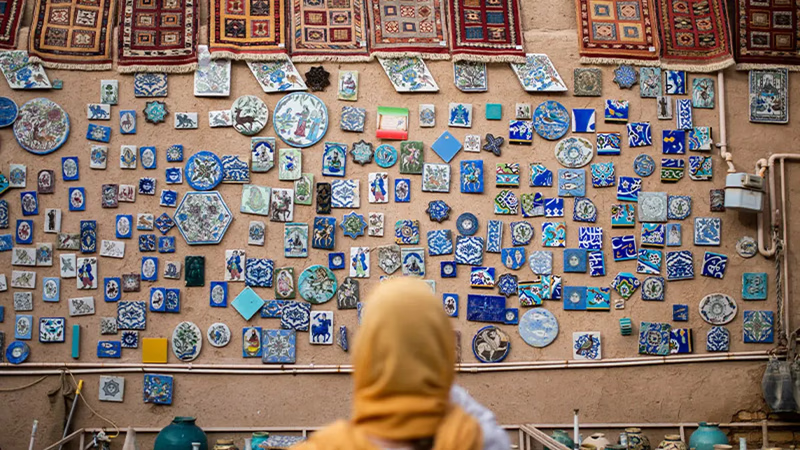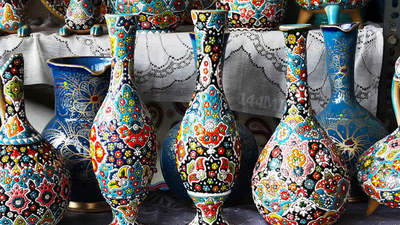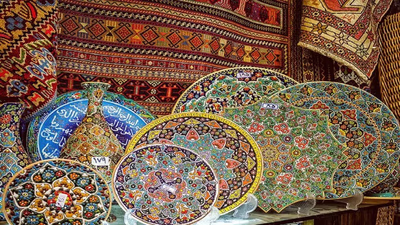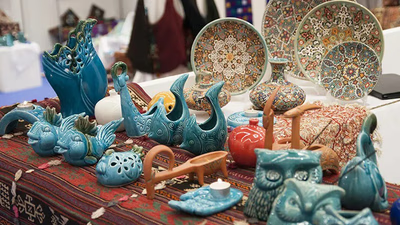
Handmade jewelry and carpets showcase West Asia"s rich handicraft tradition."
The West Asian region has always been one of the important centers of handicrafts in the world with 14 countries, and it is one of the original and oldest industries in the Middle East. Handicrafts are the result of the interaction of industry and art, which is mixed with culture. In addition to transferring culture, handicrafts also play a significant role in generating income. June 10th has been designated as World Handicrafts Day as an excuse to celebrate the love and artistry manifested in the works of artists who pour the fragrance of their taste and talent on the inanimate body of inanimate objects. This region has always benefited from the presence of creative artists. Other advantages of this region are its growing economy and good markets.
Persian carpets, also known as Persian rugs, are renowned worldwide for their intricate designs and fine craftsmanship. These handwoven carpets often feature elaborate patterns, vibrant colors, and high-quality wool or silk materials. Turkish ceramics, particularly the art of ceramic tile making, have a long history in the region. Iznik tiles, named after the town of Iznik in Turkey, are famous for their intricate floral patterns and vibrant blue, turquoise, and white color schemes. Palestinian embroidery, also known as "tatreez," is a traditional craft practiced by Palestinian women. It involves the use of colorful threads and intricate stitching techniques to create geometric patterns and motifs on garments, pillows, and other textiles.
Mosaic art has a strong presence in Lebanon, particularly in the city of Sidon. Skilled artisans create intricate mosaics using colored glass, stones, and ceramics to form beautiful patterns and scenes on walls, floors, and decorative objects. The Khanjar is a traditional curved dagger that is an integral part of Omani culture. These ceremonial daggers are made with intricate silverwork, often featuring ornate handles and sheaths adorned with precious stones. Yemeni jewelry is known for its intricate silver craftsmanship and unique designs. The jewelry often features filigree work, granulation, and colorful gemstones, reflecting the cultural and tribal traditions of Yemen.
Copper craftsmanship is well-established in Iraq, particularly in the city of Baghdad. Skilled artisans create intricately engraved copper utensils, trays, and decorative items, showcasing traditional motifs and designs. Jordan has a tradition of pottery making, with the city of Madaba being particularly famous for its ceramics. Jordanian pottery often features hand-painted geometric patterns, arabesque designs, and earthy colors. Damascene craft, originating from Damascus, Syria, involves the art of inlaying metalwork with silver or gold threads into intricate patterns on various objects such as swords, trays, and jewelry boxes.
In the current era, when handicrafts have become an important source of added value and economic productivity of West Asian countries, along with national and regional identity, in the Middle East due to some obstacles and problems, this industry has distanced itself from its position and is far from playing a role in the economic arena. has been All these factors have led to the fact that handicrafts play a minor role in increasing employment and eliminating unemployment and income generation, and on the other hand, they lose the dream of competing and influencing more and more in the international markets.
Handicrafts, with their historical background, are considered valuable cultural, artistic and industrial goods in terms of their place in the culture and art of the Middle East. These products should be given more attention due to their essential role in providing people's livelihood, especially some villagers and nomads. Our region can be one of the major exporters of such products in the world due to the special characteristics of tourism and having the first place in terms of variety of handicrafts.
The existence of 295 registered and active handicraft fields and the revitalization of 115 obsolete and forgotten fields, the large community of more than 2 million people in the business chain in this area requires to maintain this valuable market which has the capacity to gain a suitable position in the global markets. Governments and parliaments, legislators and executives, by passing protective laws and implementing infrastructure measures and plans, should always support the activists of this cultural and economic sector.
Handicrafts are one of the connecting factors between culture, economy and art, and neglecting this sector and the lack of supporting policies have many negative consequences, including the decline in the quality of artworks, lack of job stability, market stagnation, and the loss of the status of art. It follows West Asia in the economy. Unfortunately, this region, despite its many capacities, has always suffered crises and injuries, such as Syria, Yemen, Bahrain, and Iraq, which are constantly at war, and unfortunately, only the artists of these countries suffer because of these crises and unrest.



